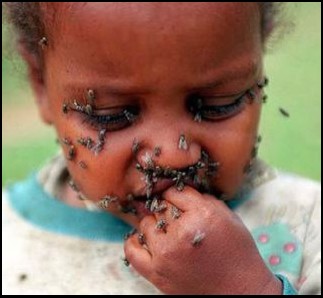Almost all of the poorest billion human beings are infected by one or more infectious diseases. These diseases cripple, disfigure, and scar their victims, often leaving them subject to lifelong stigmatization or severely impairing their cognitive and economic potential.
A cluster of chronic parasitic and other common illnesses – collectively known as neglected tropical diseases – afflicts 1.4 billion people, more than one sixth of the global population. Unlike malaria or HIV/AIDS, the names of these diseases may be unfamiliar (hence “neglected”). But their prevalence and destruction is staggering.
Roundworm infects 807 million people worldwide, whipworm infects 604 million, and hookworm infects 576 million. The four other most common NTDs include snail fever, affecting about 200 million people; lymphatic filariasis elephantiasis, which affects 120 million people; blinding trachoma, affecting more than 80 million people; and river blindness, which affects almost 40 million people. Combined, due to their chronic nature and the enormous hardship they create, neglected tropical diseases may do as much harm as malaria.
Although sometimes deadly in their own right, neglected tropical diseases mostly cause chronic disability. Trachoma, for example, causes swelling of the eye, corneal scarring, and eventually permanent blindness. Schistosomiasis leads to painful, bloody urination, bloody diarrhea, enlargement of the liver and spleen, and liver cancer (as well at least 300,000 deaths annually). Lymphatic filariasis is well known for profound swelling it can cause of the extremities, leaving its victims crippled. In addition, these infections generally cause abdominal pain, loss of appetite, malnutrition, diarrhea, and anemia.
The rashes, scars, and swelling of limbs which result from neglected tropical diseases can lead to the ostracization of victims, especially for young women, who are often considered unmarriable after the disease takes it course.
Neglected tropical diseases also exacerbate the deleterious effects of other diseases, such as HIV and malaria. Female genital schistosomiasis infection causes lesions which increases the risk of HIV transmission threefold, for example. Co-infection of hookworm and malaria, a common occurrence in Sub-Saharan Africa, can lead to severe anemia, a problem which is especially acute for pregnant women.
Pregnant women with anemia are three-and-a-half-times more likely to die during childbirth than women who are not anemic. For pregnant women in sub-Saharan Africa—a quarter to a third of them are infected with hookworm—this contributes significantly to maternal mortality. Pregnant women infected with neglected tropical diseases are also more likely to give birth to low-birth weight babies and babies with cognitive and developmental problems.
Once born, impoverished children are themselves “the most vulnerable to these diseases.” For example, three-quarters of children in Rwanda suffer from a parasitic worm-transmitted infection. These parasites, which continually feed on the blood of infected children for several years, severely and irreversibly impair child development. Studies have attributed childhood infection with neglected tropical diseases to increased school absenteeism, significant cognitive deficits, reduced lifetime income, and decreased literacy. In fact, childhood hookworm infection has been shown to reduce future wage earning capacity by 43 percent.
The result is a poverty trap: due to deficient sanitation, little access to health care, and proximity to conflict, the world’s “bottom billion” are particularly vulnerable to neglected tropical diseases; these diseases, in turn, deprive their victims of the ability to improve their position. As one author put it, “we now have an increasing body of evidence that the reason the poorest of the poor are trapped in poverty is because the NTDs block their ability to achieve their full mental and physical capacity and live a normal life.”
And the poverty trap goes full circle, as the victims of neglected tropical diseases tend to be politically marginalized and unable to shape public policy towards mitigating these diseases. Consequently, the political response has at all levels been inadequate.
In a very real sense, then, disease makes poverty permanent, condemning hundreds of millions of people to lives which are nasty, brutish, and short.
[image credit: http://tap.pmhclients.com/images/uploads/about/ntd4.jpg]

















